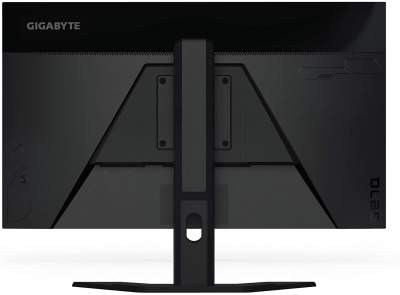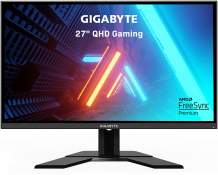Gigabyte G27Q Review
While responsiveness and speed are perhaps the most important aspects of a gaming screen’s overall performance, image quality is just as crucial when looking for the ultimate gaming monitor on the market. It is not enough for a monitor to simply have high contrast or a wide color gamut. The interplay of these factors is also important to consider. When a display achieves perfection in every aspect, it stands out from the crowd.
The Gigabyte G27Q is a high-quality gaming monitor that provides increased performance thanks to the 144Hz refresh rate, G-Sync compatibility, and reduced motion blur. In addition, it provides excellent image quality with a wide color gamut when used in sRGB mode. The device also has a USB 3.0 port and can receive HDR signals with a resolution of 1440×900 pixels and 10 bits of color depth.
This is a solid product that falls somewhere in the middle of the value and premium categories. Put another way, it is somewhat less expensive than the original 27-inch 1440p monitors that debuted around eight years ago, but it offers much better performance and is arguably the best gaming monitor under 300 dollars with a 1440p resolution.
Gigabyte G27Q Specifications
| Screen Size | 27-inch |
| Aspect Ratio | 16:9 (Widescreen) |
| Panel Type | IPS |
| Resolution | 2560×1440 (QHD) |
| Response Time (Aim Stabilizer) | 1ms (MPRT) |
| Response Time (GtG) | Not specified |
| Refresh Rate | 144Hz |
| Adaptive-Sync | FreeSync (48-144Hz) |
| Brightness | 350 cd/m² |
| Brightness (HDR) | 400 cd/m² |
| Ports | DisplayPort 1.2, 2x HDMI 2.0 |
| Other Ports | Headphone Jack, 2x USB 3.0 |
| Speakers | 2x2W |
| HDR | DisplayHDR 400 |
| Contrast Ratio | 1000:1 (static) |
| Colors | 1.07 billion (8-bit + FRC)92% DCI-P3 |
| VESA | Yes (100x100mm) |
Image Quality
Based on an IPS panel, the Gigabyte G27Q monitor displays accurate, consistent, and bright colors. It also has 178° broad viewing angles which ensure that the image is perfect no matter what angle you are viewing the screen from.
In terms of coverage, it covers 92 percent of the DCI-P3 color space, which is equal to about 120 percent of sRGB using a native 8-bit color/bit depth. You get more realistic and vibrant colors as a result.
Using the sRGB option to restrict the gamut to about 100 percent can provide a more accurate color output for sRGB content if that is what you prefer. Note that you can also change the brightness in this mode if you want to do so.
Whatever game you’re playing, the G27Q will look incredible on it.The G27Q’s vibrant colors and sharp contrast immediately caught our attention. It has a dynamic contrast ratio of 12M:1, and it shows. Dark to bright regions have great clarity since the colors are bold and vivid. There are also many controls to allow you to tune the display to your preferences.
Other panel-related features include a static contrast ratio of 1,000:1, typical of an IPS panel monitor, and a peak brightness of 350 nits, which results in an image that is more than bright enough under regular lighting circumstances.
In addition, the Gigabyte G27Q display supports HDR (High Dynamic Range) and has been certified by VESA to the entry-level DisplayHDR 400 standard. However, as we all know, it’s a hit or miss based on the game, and most of the HDR mode’s advantages are at best limited.
Because of the low contrast ratio, you won’t receive the “true” HDR visual experience, which is only available on much more costly displays. HDR content gets a bump in peak brightness up to 400 nits and makes excellent use of the monitor’s broad color gamut.
In addition, the panel achieves blistering brightness, which is required for it to get VESA Display HDR 400 Certification. While HDR gaming on Windows is still in its early stages, when it does work, it is really stunning. In everything from The Division 2 to Marvel’s Avengers, the colors are vibrant and have a visceral effect, and there is a clear distinction between dark and bright tones. However, at maximum brightness, sunny sky and other bright areas tend to blow out and lose clarity. Dark regions may also be crushed sometimes.
1440p resolution is excellent for 27-inch monitors because it provides an optimum pixel-per-inch ratio of 108 PPI, which results in lots of screen space and crisp details and text without the need for scaling.
Performance
Picture Quality, Balance, and Speed are three response time overdrive modes on the Gigabyte G27Q.
The fastest setting is ‘Speed,’ which successfully reduces ghosting behind fast-moving objects at 144Hz without causing any noticeable overshoot.
With a dynamic range of 48-144Hz and LFC (Low Framerate Compensation), AMD FreeSync prevents screen tearing and jitter at up to 144 frames per second.
The Gigabyte G27Q is a FreeSync gaming monitor that also supports Nvidia’s G-Sync compatibility mode. It’s wonderful to have options for VRR solutions, especially since both GPU manufacturers are now manufacturing cards capable of 1440p gameplay. At 144Hz, the input lag is 4ms. Thus there will be no delays or de-synced instances.
You can utilize the Aim Stabilizer technology instead of VRR to minimize apparent motion blur. It uses backlight strobing at a constant refresh rate. It can’t be used in conjunction with FreeSync, and it dims the monitor’s brightness when it’s on.
While Aim Stabilizer may help with motion clarity in fast-paced games, for the greatest performance and the least amount of strobe crosstalk, your frame rate must match the refresh rate of your display.
The input lag on the Gigabyte G27Q is just four milliseconds, resulting in an almost unnoticeable wait between your inputs and the results on the screen.
Finally, the display has a 10-level low-blue light filter and a flicker-free backlight (unless Aim Stabilizer is turned on).
As you’d expect from an IPS panel monitor, some IPS glow is visible. However, bear in mind that the quantity of IPS glow varies throughout units.
Design and Features
The Gigabyte G27Q looks similar to the G27QC. However, it features a flat screen rather than the curved display seen on the latter. Except for those who know what Gigabyte stands for, the monitor maintains its basic matte black design, making it seem to be just like any other model at first sight. Although the display has no bezels on three sides, it still has panel borders during use.
We appreciate how the Gigabyte G27Q is more sleek and thin than the curved version, so it doesn’t take up too much room. However, the stand and base, which have broad feet, still have the same construction. Small peripherals can be inserted in between, although this isn’t the most space-saving approach we’ve seen in recent editions.
| The Gigabyte G27Q boasts excellent build quality for an affordable monitor with a robust and durable chassis. Although the monitor is mainly made of plastic, it does not seem to be brittle or flimsy. The stand has a little wobble to it, but it’s only apparent if you inadvertently push it or use the back controls. The accompanying stand does a decent job of keeping the Gigabyte G27Q standing, but unlike its rivals, it only allows for tilt and height adjustments. Most customers will be satisfied with that, but we are aware that the market is now demanding the most value from a gaming device. You can replace it with a VESA mount, but unless you’re building a multi-monitor setup or have limited space, it’s not necessary. |  |
The Gigabyte G27Q comes with a joystick to assist users in using it more easily and quickly. It’s simple to reach and serves as a power button, and the layout makes it difficult to accidentally turn off the screen. You can also utilize Gigabyte’s OSD Sidekick function, which allows you to use a keyboard and mouse to manage the monitor’s capabilities right on your desktop.
The I/O configuration of the Gigabyte G27Q isn’t skimpy since it contains pretty much everything you’ll ever need. DisplayPort 1.2 and two HDMI 2.0 slots are included for signal inputs, which are plenty for your game PC as well as two consoles on the side. The display also comes with two USB 3.0 connections and a 3.5mm socket, which will come in useful for cable management.
The Gigabyte G27Q even has speakers built into the chassis, making it a better value for money than other cheap options. The disadvantage is that the pair only has 2 watts of power, which is insufficient for the product’s intended purpose. However, having spares or secondary devices that can be utilized for small chores like conference calls or simply background music is always a good idea.
Display
The Gigabyte G27Q has a 27-inch IPS panel with a resolution of 2560 x 1440, a refresh rate of 144Hz, and a response time of 1ms MPRT. The backlight is 350 cd/m2, and the contrast ratio, like most IPS screens, is 1000:1.
When it comes to visibility and clarity, the 27-inch 1440p screens provide the ideal sweet spot, and it is rapidly becoming the ideal computer resolution for many people. Although the clarity and desktop space have improved, text and other tiny items are still simple to view and understand. You won’t require scaling, but you may need to update your GPU to play AAA games at high frame rates.
Despite being a budget gaming monitor, the Gigabyte G27Q supports 120 percent sRGB and approximately 89 percent DCI-P3 for great vibrancy. The default accuracy could have been better, but that’s still excellent for a gaming display. It is somewhat better than the VA-based version, although it does have a color accuracy advantage.
With HDR enabled, the backlight of the Gigabyte G27Q achieved 420 cd/m2 at 100 percent brightness. Raising the display’s dynamic range isn’t enough, but there’s plenty of room for tweaking. Its contrast ratio isn’t quite as good at 1040:1 with 50% backlight, but that’s something you have to compromise when selecting IPS panels.
The Gigabyte G27Q’s panel uniformity is excellent, although there is some minor clouding while viewing an all-black picture. In colorful scenes, it’s hardly visible, but in darker situations in games like Cyberpunk 2077, there’s a little clouding emanating from the top edge. Be aware, though, that this varies from one IPS panel to the next.
The Gigabyte G27Q’s pixel response time is very impressive since it lacks any ghosting and blurring. Setting the overdrive mode to Speed reduces the already low persistence at the cost of slight overshoot that you will most likely not notice. We’ll leave it up to you to figure out which works best for your graphics by lowering the overdrive by a level.
Final Thoughts
If you want a powerful gaming monitor with outstanding colors and speed while saving money, the Gigabyte G27Q is an excellent option. The budget model has excellent color quality and responsiveness, but there are certain drawbacks that may be a problem for the most discerning gamers. However, we appreciate how Gigabyte didn’t compromise on the key features of this model, so we’re certain that many people will like it.

